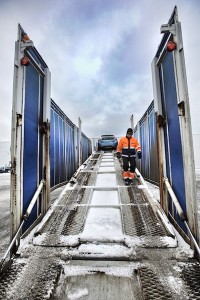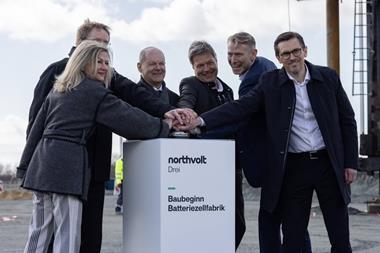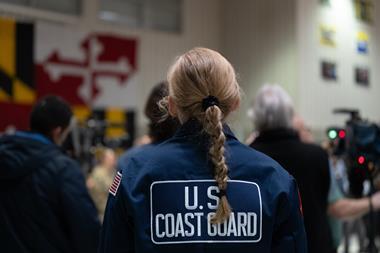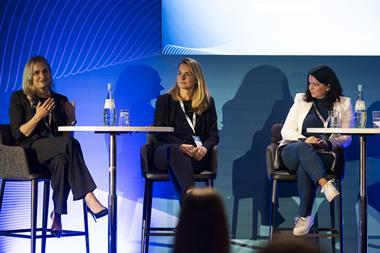The decision to bring logistics purchasing and operations in-house has resulted in dramatic changes in Volvo Car Group’s inbound and outbound supply chain.
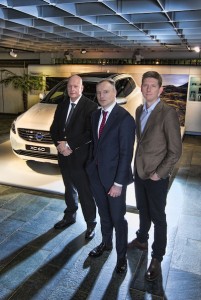
Four years after China’s Geely Cars bought Volvo Cars from Ford, the Swedish carmaker is undergoing the most significant ever change to its manufacturing and sales footprint. Since last November, it has opened two new assembly plants and an engine factory in China, with another to be built as the carmaker aims for a long-term sales target of 200,000 cars per year in the country; its global sales ambition now runs to 800,000 units (from 427,000 in 2013).
There has been a big rise in the carmaker’s vehicle flows to the east – last year exports to China from Volvo’s European factories in Torslanda, Sweden and Ghent, Belgium rose 45% compared to 2012, nearly matching those to the US, traditionally its largest market. Shipments to Japan have also grown substantially, surpassing those to Russia and Italy.
This export balance may yet change again. Major model launches in the US aim to restore sales there. Meanwhile, local production will ramp up in Chengdu, in southwest China, along with a smaller plant in Daqing in the northeast (Changan Ford continues to build Volvos on contract in Chongqing). Volvo Car Group chief executive, Håkan Samuelsson, has even indicated that the OEM is considering exporting vehicles from China to the US.
Look closely for important changes
Changes such as these are groundbreaking (literally so with greenfield plants in China). However, akin to its traditionally more reserved, Scandinavian culture, there are subtler, though no less important innovations beneath the bonnet at Volvo – particularly across the manufacturing and logistics chain.
For example, the carmaker is extending the assembly line for the all-new XC90 at its plant in Torslanda, at Volvo’s global headquarters near Gothenburg. This will be the first model built on the new platform developed under Geely ownership. Volvo is adding a new bodyshop at Torslanda, which deputy plant manager Michael Gustavsson says will be a forklift-free environment. The plant already builds seven models, including the hybrid V60 added last year.
There are also supplier and logistics provider changes. Several sequence suppliers based close to the plant have been or are in the process of being brought in-house to reduce cost, including transport and handling, says Gustavsson. For outbound, there is a new logistics provider, Logent, operating the Torslanda vehicle yard; scanning in, parking and loading vehicles that come off the assembly line or those brought in from Ghent for the Scandinavian market. A number of carriers new to Volvo also pull up in the yard to load vehicles. Observers in Ghent would note similar changes there.
Indeed, some differences are even less evident to the naked eye. Since last year, providers operate on a yard management system called ATACQ (Answer To All Car Questions), derived from the carmaker’s assembly line quality system. Volvo first rolled out the yard system in Ghent and now also uses it in Chengdu, where its European processes and strategies for yard management have been replicated.

With such control over vehicle inventory and cash flow, the TMS puts Volvo’s logistic team at the “heart of the company’s order-to-delivery process”, according to Magnus Ödling, head of network strategy and business applications, who is overseeing the system solution. With two-thirds of the company’s working capital tied up in inbound and mainly finished vehicle inventory, the role that logistics and its systems play in reducing those stocks has come into sharper management focus, he says.
Taking logistics out of the ‘blackbox’
At the core of these new systems, processes and providers is a crucial organisational shift for Volvo’s supply chain management. The carmaker has brought its logistics purchasing and operations in-house – first for outbound in 2012 and, as of January 2014, for inbound – from Volvo Group Logistics Services (VGLS, formerly called Volvo Logistics), the in-house third party provider at truckmaker Volvo Group (see box below). Today, the new Volvo Car Group team is responsible for network design, purchasing, operations and customs, led since June 2012 by David Pansinger, vice-president of inbound and outbound.
 To understand Volvo’s rationale for insourcing logistics, Pansinger goes back to 1999, when Volvo Group sold its passenger car operations to Ford. The American OEM decided that certain functions at Volvo Cars were not ‘core competencies’ – including logistics and IT – and should be purchased as a service. It hired Volvo Logistics to manage and procure logistics for the carmaker, including inbound consolidation, transport to factories and vehicle distribution. In some cases Volvo Logistics directly operated logistics too, including returnable packaging and vehicle yards.
To understand Volvo’s rationale for insourcing logistics, Pansinger goes back to 1999, when Volvo Group sold its passenger car operations to Ford. The American OEM decided that certain functions at Volvo Cars were not ‘core competencies’ – including logistics and IT – and should be purchased as a service. It hired Volvo Logistics to manage and procure logistics for the carmaker, including inbound consolidation, transport to factories and vehicle distribution. In some cases Volvo Logistics directly operated logistics too, including returnable packaging and vehicle yards.
By 2011, Volvo’s new management team saw things differently. IT applications were considered increasingly important to managing sales, production and the supply chain. Meanwhile, logistics cost and performance had become a “blackbox”, says Pansinger. “Volvo Logistics picked up vehicles at the factory and dropped them off, and we paid for it,” he says. “It became very disconnected to our management.”
Volvo initially considered retaining VGLS. Ulf Säker, purchasing manager for inbound and outbound, was involved early on. He first came into logistics in 2011 after a career in labour agency services, engineering and material purchasing. “One of my first tasks was to see how we could develop a purchasing department and then operate together with Volvo Logistics, or if we should go another route,” he says.
The decision came down to Volvo Cars wanting to have more in-house competencies. While VGLS expanded the carmaker’s network, combining flows with Volvo Group and other manufacturers where possible, the “blackbox” effect outweighed economies of scale. “Without market knowledge in logistics, it is difficult to challenge or impact a price, whether in negotiations or operations,” says Säker.
The insourcing of logistics from Volvo Cars obviously has an impact on Volvo Group Logistics Services (VGLS), which managed the carmaker’s supply chain for decades. Christer Svärd, senior vice-president of the division, confirms that VGLS will cease to provide any services to Volvo Cars from this year.
However, Svärd plays down the overall effect on VGLS. The provider’s main focus, he says, has always been its parent, the commercial vehicle manufacturer, Volvo Group. Following a recent restructuring of the group, VGLS will concentrate even more on finding internal efficiencies. “VGLS is more focused on the Volvo Group in the new Volvo Group organisation,” he says, adding that there is significant potential to improve logistics among Volvo Group’s joint ventures in Asia.
Furthermore, Svärd essentially agrees with Volvo Cars’ new logistics management that there have been fewer and fewer opportunities to combine logistics and find economies of scale between the Volvo Group and Volvo Cars following years of separate ownership. “VGLS has provided substantial cost savings to Volvo Cars during our long co-operation,” he says. “However, during the last 15-20 years, Volvo Cars and the Volvo Group have gradually decreased the number of common suppliers, hence also decreased the synergies in working together.”
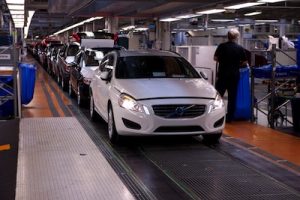
Svärd says VGLS is open to co-operation with the carmaker, whether in shared shipping and rail routes or in procuring services from external logistics providers. However, it’s clear that the main objective is to be an internal logistics centre for the Volvo Group. “We aim to design, manage and optimise logistics services for the Volvo Group and to be the logistics services centre of excellence within the group,” he says.
Volvo Car Group went on to refresh its entire supply chain management. It recruited a new team to learn the market, run tenders and launch a TMS in less than a year each for outbound and inbound. The time periods were brutally short, but Pansinger has made something of a career out of building up logistics departments from scratch. In the early 1990s he helped start a production control and inbound logistics group at Eurostar, the joint venture for building Chryslers in Graz, Austria that was later absorbed into contract manufacturer Magna Steyr. He also started an outbound logistics department for Chrysler at its former sales office in Brussels, before working on the logistics integration of the DaimlerChrysler merger. Later, he helped create a supply chain management organisation for Mitsubishi Motors Europe, after it had acquired the Nedcar factory in the Netherlands (which also once built Volvos, and is today used for BMW Mini). “I don’t recall ever having a job [in automotive logistics] where I took over from someone else,” he says. “It was always in relation to a start-up.”
Despite Pansinger’s experience, most on the logistics team are new to the carmaker or automotive logistics. Only a quarter of staff was hired internally, with just a few from Volvo Group or Saab. Some came from logistics providers, such as Ödling, who worked more than 12 years in various commercial and supply chain management roles at Damco, the freight-forwarding arm of the Maersk Group.
Last year, Volvo’s management made another change by combining purchasing and manufacturing, which also incorporates inbound, outbound and in-plant logistics. Thus, operational and purchasing teams share reporting lines, a structure that had never been in place before for Volvo. Pansinger reports to Geert Bruyneel who runs the newly established supplier quality and logistics department; he in turn reports to the senior vice-president for the major purchasing and manufacturing team, Lars Wrebo.
The result for logistics management is a broader scope than anything that had been in place before at Volvo, with the combined teams keeping a tight rein over network design and changes. Ödling believes that logistics has also benefited from using more processes that team members like Säker brought in from material purchasing, including joint negotiations and supplier communication between the operations and procurement teams.
A logistics work-in-progress
Volvo’s new logistics administration has significantly changed its operations and carrier base. One of the most critical decisions was the TMS. The company originally planned to use a VGLS system as a carry-over solution, but eventually chose a product by IBM. Although it is an off-the-shelf system, Ödling says Volvo’s in-house IT team has added half of its features, mostly for the carmaker’s order-to-delivery processes. “You have the actual TMS that sends EDI signals back and forth to carriers, plus a self-billing aspect through SAP,” he says. “Then you have the complete ‘order-to-delivery’ process and logic built by Volvo and IBM in close collaboration.”
Decisions in purchasing have also been notably different, with Volvo consolidating volume across fewer providers than VGLS had previously. In continental Europe, for example, Volvo uses five road carriers whereas VGLS used as many as 15, says Säker. In Scandinavia, the company also uses five providers (three in Sweden and one each in Norway and Denmark). For inbound road, Volvo has reduced its carrier base to fewer than 20.
Pansinger does not claim that the team is doing everything better than VGLS did; rather, the operations are works-in-progress. He admits that the carmaker may have over-simplified its provider base in the launch phase. “We might not yet have the most fully optimised version,” he says. “We want eventually to move to more regional strength, but to start it up we went for more door-to-door services.”
 "We need to reduce our working capital and we now have more of the tools and data to do that... we have a completely different level of information and intelligence"
"We need to reduce our working capital and we now have more of the tools and data to do that... we have a completely different level of information and intelligence"- David Pansinger, Volvo Cars
Pansinger also acknowledges there have been system hiccups, with the new teams and carriers also causing some disruptions. “There are areas in which we have paid dues, or where we have had to re-evaluate contracts,” he says.
While more change is likely to come in Volvo’s outbound operations and carrier base – Ödling points in particular to opportunities in upcoming tenders for 2015 – the new structure provides the visibility and control over logistics costs that the company sought.
“We need to reduce our working capital and we now have more of the tools and data to do that,” Pansinger says. “From what had been a blackbox, we now have a completely different level of information and intelligence.”
The logistics team at Volvo Car Group is also expanding its responsibilities in overseas markets. “We are increasingly stepping into a global governance model for outbound, starting with the larger markets and then going into the smaller ones,” says David Pansinger.
That will eventually include the US, for which the team currently has responsibility up to four entry ports, otherwise acting as a consultant to the local sales company.
China, on the other hand, is more integrated. Although the local sales company formally has responsibility from the port of Shanghai and the plants, Pansinger and his team have functional responsibility for tenders and for making purchasing recommendations. For example, in February, Volvo awarded contracts to WWL and Anji Logistics for outbound services for the Chengdu and imported volumes through Shanghai, including managing an off-site vehicle yard close to the plant.
The rollout of Volvo’s TMS in China also gives Gothenburg an important view over day-to-day operations. “For China we have a handover to the national sales company, but then we continue with the TMS all the way to the dealers,” says Magnus Ödling. “We have implemented the new routes out of Chengdu in the system, which we steer all the way to end delivery with our local team.”
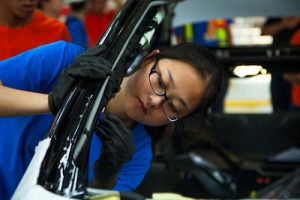
Pansinger says Volvo will also explore sharing logistics with Geely Cars, which is run separately. Geely has a decentralised management structure with each of its factories responsible for logistics, but there are opportunities – Volvo’s plant in Chengdu is next to Geely’s and Volvo’s off-site vehicle yard could be an opportunity for future sharing. “The discussion has already started. We have a governance model in place for Volvo and I think in a very short time we would be ready to bring Geely into the agenda to find synergies,” Pansinger says.
Not everything has been about change for Volvo’s logistics. Those familiar with the carmaker’s logistics often refer to the ‘backbone’ of its outbound distribution – a short-sea shipping loop out of the ports of Gothenburg and Ghent. Known as the ‘Eurobridge’, this loop remains Volvo’s most important linking point, supporting movement by sea of more than 50% of Volvo’s European distribution, according to Pansinger (see illustration above).
The basic principle hinges on the proximity to ports for both plants – Torslanda, a five-minute drive on a non-public access road to Gothenburg, and Ghent, within a kilometre of the port and just across the road from the yard. The ports are linked by a six-times-weekly ro-ro service, operated by DFDS, which exchanges both new vehicles and trailers with inbound Volvo material and other cargo.
The Eurobridge is an important legacy from VGLS, which established it with DFDS more than 20 years ago. Volvo Group’s own finished trucks and materials share the route, moving between the company’s plants in Gothenburg and Ghent. The effectiveness of the Eurobridge for Volvo Car Group lies in its onward transport connections. Vehicles from both Gothenburg and Ghent are combined for distribution to Scandinavia, the UK, continental Europe and occasionally deep-sea destinations. For example, DFDS moves six times per week between the port of Gothenburg and Immingham on the English east coast. Ghent and its neighbouring ports serve the southern UK via Southampton, as well as Denmark, southern Italy and elsewhere.
 The links to Eurobridge are truly multimodal. Flows are combined in Ghent and moved by road to Volvo’s main markets in west and central Europe. In Gothenburg, cars are hauled the short drive to the yard in Torslanda, where they meet local production for road distribution in western and southern Sweden, and for rail service to northern Sweden and to Stockholm, from which they also move to Finland.
The links to Eurobridge are truly multimodal. Flows are combined in Ghent and moved by road to Volvo’s main markets in west and central Europe. In Gothenburg, cars are hauled the short drive to the yard in Torslanda, where they meet local production for road distribution in western and southern Sweden, and for rail service to northern Sweden and to Stockholm, from which they also move to Finland.
The plants also share extended sea connections via ‘short’ and ‘long’ transport runs. From Torslanda, vehicles move ‘short’ to Gothenburg, where there is both the short-sea terminal for Eurobridge (a facility run in a joint venture by DFDS and Cobelfret) and a deep-sea terminal run by Logent. WWL calls at the deep-sea terminal with services to North America and Australia.
The long run from Torslanda is 50km north to the port of Wallhamn, which is served by, among others, Eukor and UECC, with services to Russia, China and Japan.
While the short run for Ghent is to the adjacent port, it has two long runs to huge ports; 60km east to Antwerp, and a similar distance west to Zeebrugge.
Pansinger and Ödling do not insist that the Eurobridge structure should change. However, looking ahead to tenders scheduled this year, they stress that Volvo will look for new opportunities, including minor and radical adjustments.

“We are in concrete discussions with companies and it may come back to VGLS,” says Pansinger. “If they have railcars going down to Ghent with cabins and we need to come back, what opportunities are there?”
“The next step is to look for major changes, either within a contract or by going into a new contract,” adds Ödling.
Säker also points out that Volvo must consider the 2015 implementation of the low sulphur emissions area in Europe and its impact on bunker prices. “It is on our radar and we are studying the responses and technology that shipping lines will use to meet the new standards by January 1st,” he says. (Read here for more on the sulphur changes.)
Looking to new networks and perfect sequence
On a global level, shaping the Chinese network is a major focus for Volvo, including both the domestic network from plants as well as the port network. The carmaker currently ships only to Shanghai and is studying if it should add more locations.
Elsewhere, the company plans to review its port structure in North America, along with the organisation between the US and Canada, which are separate entities. “Do we need two separate [logistics] organisations, with five ports between them?” asks Pansinger. He also suggests that Volvo will consider rail options in North America, which it so far hasn’t used. “Our main markets used to be mainly at the coasts, but that is changing and we should look again at our distribution structure.”
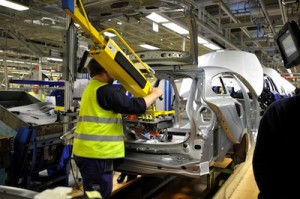
Indeed, Volvo is moving further in this direction. The difficulty is that the carmaker’s product variation often leads to line changes; at Torslanda, frames arrive from different bodyshops, while the seven models are built individually rather than in batches. This makes it hard to predict the order in which cars will be produced, so it is difficult to plan transport orders in advance.
However, Pansinger points to a Volvo programme called ‘perfect sequence’, which would better synchronise the production schedule and allow a more reliable vehicle pipeline. “The ‘perfect sequence’ would then be extended to the yard, terminals and shipping lines, steering the carrier more on when to arrive and pick up cars,” he says.
That ambition is not yet a reality. As is common in the sector, Volvo currently signals carriers to pick up vehicles once they are complete, which means the sequence of distribution is not always precisely scheduled. With Eurobridge, for example, although the plants are close to the ports, ships leave almost every day and though the sailing time between Gothenburg and Ghent is 36 hours, it takes about six days to reach the Ghent yard from release at Torslanda. Pansinger blames this disconnect on unnecessary dwell times at yards or ports.
Looking for those who can automate
While better upstream planning will help distribution, Pansinger also wants to study the downstream data more carefully. The TMS is a vital tool in this regard. The system tracks the time between signals to build loads, as well as when providers report pickups and delivery. Volvo can thus study potential routes and loading improvements, while determining what its contracted lead times should be, says Ödling.
However, Ödling stresses the importance of carrier discipline in accurate reporting. Although this is required by contract, Volvo depends on a provider’s ability to send EDI messages or follow protocol. During the upcoming tenders, Ödling says Volvo will look favourably on providers with greater technological capacity, including the use of mobile or paperless processes. “What suppliers do to control their integrity in the system would help us. We would react positively to those carriers that have drivers equipped with connected scanning, smartphone or tablet systems,” he says.
 "We would react positively to those carriers that have drivers equipped with connected scanning, smartphone or tablet systems"
"We would react positively to those carriers that have drivers equipped with connected scanning, smartphone or tablet systems" - Magnus Ödling, Volvo Cars
Pansinger expresses wonder that there could still be reluctance among European carriers today to use EDI, having worked to link carriers in automated systems in the 1990s on behalf of Chrysler and with Mitsubishi in 2002. “It’s amazing that all these years later, there is still some resistance to connect,” he says. “There are very popular [carrier] names in the industry that are surprised, or at least slow to react, when you want EDI.”
Pansinger contrasts the situation for inbound logistics, where there are providers that wouldn’t ship a single pallet without an EDI signal. “The inbound providers are further along in this respect,” he admits.
Something old, something new, something borrowed…
Following the ‘go live’ in December, inbound is a big focus for Pansinger’s team. Its responsibility includes managing supply from European (and increasingly global) suppliers to Ghent and Torslanda, plus powertrain and stamping plants in Sweden. Volvo also uses facilities in Gothenburg, Ghent and Maastricht to combine material for overseas production (besides China, Volvo has a kit assembly plant in Malaysia).
This year the carmaker is also taking over its own returnable packaging system (replacing that of VGLS).

Pansinger clearly sees a bright future for Volvo and its logistics. It’s not often that a company gets the opportunity to introduce a new organisation and build a network around greenfield plants, as it has in China. At the same time, not everything can be new – the Torslanda plant turns 50 years old this summer, as will Ghent next year. The Eurobridge is likely to remain a fixture for distribution. However, with new models and platforms already allocated to these plants, and vehicle flows shifting, Volvo’s ability to stay ahead of supply chain changes will be important.
Logistics is now clearly high up on the agenda and the inbound and outbound team is at the heart of an ambitious ‘value chain transformation’ programme that Volvo has launched this year with a focus on lean principles. “We see a wide area of opportunities in outbound and where we want to go with inbound,” says Pansinger. “Some of that is catching up to our competition, but in certain areas we want to be ahead of it.”

















